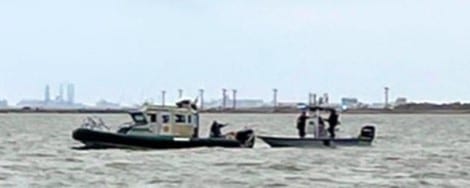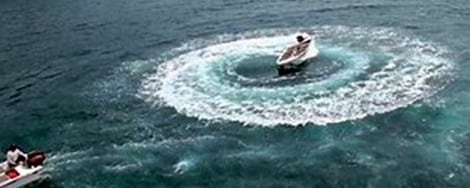 By Bob Currie, Recreational Boating Safety Specialist
By Bob Currie, Recreational Boating Safety Specialist
U. S. Coast Guard Auxiliary Base Galveston Flotilla
If you fall overboard at sea or your boat sinks, how are we going to find you if you are not Dressed for Rescue wearing a brightly colored life jacket? Don’t become a body recovery statistic – Dress for Rescue!
The Local Situation – We have had several drownings in the past month that occurred in relatively close proximity to each other in Galveston area waters. In one case a 20-foot boat sank near the Galveston causeway with 5 people aboard. Three were rescued but two drowned.
The Base Galveston Flotilla of the US Coast Guard Auxiliary operates out of the US Coast Guard base on Galveston Island. They aid the Coast Guard by providing maritime observation patrols in Galveston Bay; by providing recreational boating vessel safety checks; and by working alongside Coast Guard members in maritime accident investigation, small boat training, providing a safety zone, Aids to Navigation verification, cooking in base and station galleys and aboard cutters; and as drone pilots on the Coast Guard Drone Team.
In another case a commercial crabber’s boat was found running with nobody aboard. His body was found 5 days later. In another case a wade fisherman fishing with friends off the Texas City Dike disappeared underwater. His body was located by sonar in 10-feet of water near where he reportedly went down.

Body recovery off Texas City Dike on May 16, 2021
In another case an eight-year-old boy was caught in a rip current with an undertow and drowned. In every case the victims were in the water without a life jacket. In most cases the victims were not wearing brightly colored clothing, making it even harder for rescuers to spot them. This isn’t nation-wide or even state-wide. This is right here in Galveston area waters.

An unmanned boat circles out of control. Some boats continue on straight.
Un-Manned Boat: A Closer Look
When a boat continues moving forward without anyone aboard, you can be pretty sure that the operator wasn’t wearing the federally-mandated (for most boats) Engine Cut Off Switch (ECOS). When a boat is found still moving under power with no one aboard, there is no way to tell exactly where the operator went overboard, and thus no way to tell where to begin searching for the operator. That was the case in this incident, and the issue was compounded by the fact that the operator was not Dressed for Rescue; that is, he was not wearing a life jacket. Whenever a boat operator ends up in the water while the boat is moving, it is often the case that they hit their head on the way out and end up unconscious in the water. With no life jacket, an unconscious person has nearly zero chance of being rescued. Instead, at best it becomes a recovery operation. In this case the search pattern covered 49 square nautical miles over two days. Seas were one foot, which is relatively calm for this time of year. Had the victim been wearing a life jacket, his head would have been held at wave height above a wave trough. In this type of sea state we can generally spot a head in the water only when we are quite close. If the person in the water is wearing a life jacket that is brightly colored (orange is best), we can see them up to half a mile away from our boat.
Wade Fishing
The common denominator for all wade fishing deaths in our area is that none of the fishermen were wearing a life jacket. You should wear a life jacket designed to keep your head elevated. In one recent rescue, the rescued person had been in the water for nearly 48 hours. He also was in water in which he could stand, but he was on an oyster reef wearing flipflops, and his feet were shredded by the sharp oyster shells. He watched as boats passed by but could not gain their attention. His life jacket saved his life. His buddy, who was also in the water with him, drifted away in the night and drowned because he did not have a life jacket. In the recent incident, the wade fisher may have stepped in a hole; we don’t know. Quick, unexpected submersion can cause an involuntary reaction called the gasp reflex, in which the person takes a deep breath involuntarily (that means there is nothing you can do to stop it) and aspirates water. When that happens, the results are almost always fatal if the person cannot immediately stand with their head above water and try to cough the water out of their lungs. No matter how well you think you know the area in which you are wade fishing, you can never predict when or where a deep hole will develop. The old saying is you can drown in six inches of water. Don’t take a chance- Dress for Rescue!
Abandoning Ship
Whenever a boat strikes an underwater object that causes a hole in the hull, whenever a boat is swamped by wave action, or whenever there is a fire aboard, sometimes it becomes necessary to abandon ship (or boat, in our cases we deal with). Many people think they have plenty of time to find a life jacket and don it. However, that was not the case last Friday night when five persons had to abandon their boat due to it taking on water near the Galveston Causeway bridge. Of the five, three were able to locate a life jacket and put it on; they were saved. The other two occupants hit the water without life jackets and drowned. When things happen quickly, you do not have time to dig through storage lockers for a life jacket. You should have one on at all times when on the water. Dress for Rescue!
What’s the Water Like Today?
I see this question all the time on the Facebook groups. People worry about jelly fish and high bacteria levels, but then let their young children go out into the surf where there are strong rip currents and undertows. Rip currents will not pull you down. They will pull you out to sea. But we also have strong undertows that will pull you down, and it is for this reason that if you let your children go out into the surf that they (and you, for that matter) should wear a life jacket. Floaties won’t cut it. Neither will a boogie board save a child. That thing will be easily yanked from their hands when a strong wave comes along, and about one third of all surf waves are strong ones. Beach drownings are all too common. Invest in a life jacket for each child. Dress your kids for Rescue!
Good Practices for Safe Boating
If you remember and follow these good practices for safe boating, you will have a pretty good chance of getting back home safely from a recreational boating outing:
1. Life Jackets Save Lives – Wear a Life Jacket- Dress for Rescue!
2. Safe Boats Save Lives – Obtain a Vessel Safety Check
3. Knowledgeable Boaters Save Lives – Take a Boating Safety Course
4. Sober Boaters Save Lives – Never Boat Under the Influence
Summary
You have a much greater chance of surviving a boating accident if you are Dressed for Rescue; that is, wear a life jacket (preferably brightly colored) at all times, and wear brightly colored clothing underneath that life jacket. There is no excuse for not wearing a life jacket. I think your surviving family members would agree.
Note: This is my 200th column. I haven’t missed a week of publication in 200 weeks. I write this Boating Safety Column for my friends’ and neighbors’ benefits. I want everyone to come home safely from a boating outing.
For more information on boating safety, please visit the Official Website of the U.S. Coast Guard’s Boating Safety Division at www.uscgboating.org. Questions about the US Coast Guard Auxiliary or our free Vessel Safety Check program may be directed to me at [email protected]. I am available to perform free Vessel Safety Checks, and I will come to your location to perform them. SAFE BOATING!
[May-24-2021]

 Posted in
Posted in 

























Good advice Captain. But you will always have the knot heads. Keep up the good work.